In-class exercise
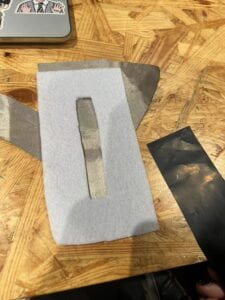
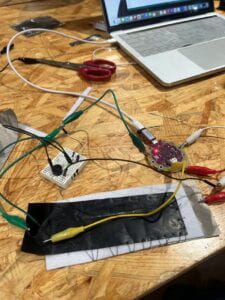
Velostat sensor 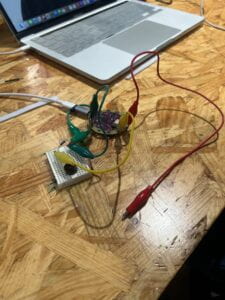
Testing Lily Pad
Final output
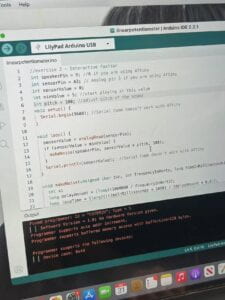
Problem encountered: My partner and I had the circuits right but the buzzer didn’t make sound. We asked Marcela and then we found that since we created quite a long velostat sensor, the resistance becomes big. The original minimum resistance value set in the sample code was 50 but our maximum resistance value was 17. So we changed the minValue to 10 to enable the buzzer to make sound.
int minValue = 10; //start playing at this value
Arduino Code:
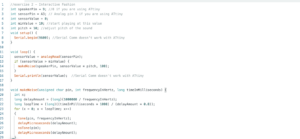
//exercise 2 – Interactive Fashion
int speakerPin = 9; //0 if you are using ATtiny
int sensorPin = A3; // Analog pin 3 if you are using ATtiny
int sensorValue = 0;
int minValue = 10; //start playing at this value
int pitch = 10; //adjust pitch of the sound
void setup() {
Serial.begin(9600); //Serial Comm doesn’t work with ATtiny
}
void loop() {
sensorValue = analogRead(sensorPin);
if(sensorValue > minValue){
makeNoise(speakerPin, sensorValue * pitch, 100);
}
Serial.println(sensorValue); //Serial Comm doesn’t work with ATtiny
}
void makeNoise(unsigned char pin, int frequencyInHertz, long timeInMilliseconds) {
int x;
long delayAmount = (long)(1000000 / frequencyInHertz);
long loopTime = (long)((timeInMilliseconds * 1000) / (delayAmount * 0.8));
for(x = 0; x < loopTime; x++)
{
tone(pin, frequencyInHertz);
delayMicroseconds(delayAmount);
noTone(pin);
delayMicroseconds(delayAmount);
}
}
Group Assignment
create a wearable device that alters your perception and changes your relationship to your environment—your personal, physical, and social world. No electronic devices and no circuits are needed for this assignment. You are free to use any material, it does not need to be “soft”.
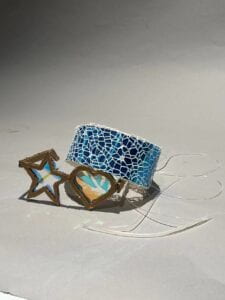
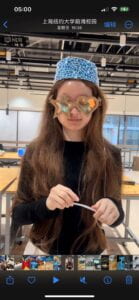
Final output
Smile and I teamed up and our idea is to create a wearable that makes people reflect on how stress will impact people’s view of the world and how others may perceive us. When we’re under a lot of stress, the color of the world in our eyes changes, and the stress will influence others to see the twisted version of themselves. This wearable aims to alter users’ perceptions of touch and sight and build a connection between mind, touch, and sight.
Our inspiration comes from the reflective and colorful fabric that we found in the fab lab.
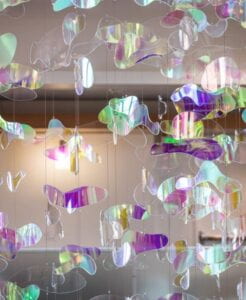
When I see these fabrics, I am reminded of the colorful hanging pictures like what is shown above. They are reflective and we can see ourselves in them, like mirrors. However, when I touch the fabric, the human image becomes deformed.
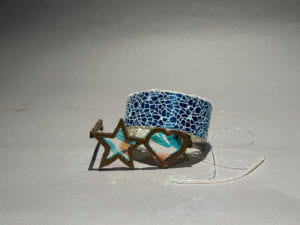
Glasses are the most common wearable that we can think of when it comes to the sense of sight. Our first idea was to cover the glasses with colorful fabric. We wanted to make a mechanism that we could change the color of the eyeglass, which is the fabric, through our motion, but it wasn’t easy to accomplish. Therefore, we simply covered it with laser-colored paper. We weren’t satisfied with the current design, and we are still thinking of some possible ways to make the glasses more interactive.
Another part of the wearable is an eye mask. The blue fabric is the reflective fabric. We wanted human motion to twist the fabric so the human image would be twisted. I experimented with sewing the cube into the fabric, and when I drag the cube, the fabric will twist. We hope to implement this in our wearable.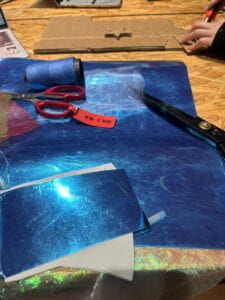

Here is the link to the video of the motion engaging the hand movement and sight we want to create.
We covered it with a hole-like white cloth, which is very much like our brain. 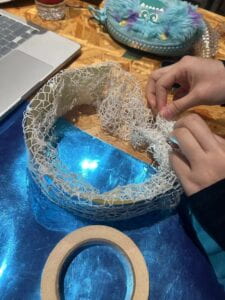

When thinking about the concept of stress, we wanted to use the glow sticks (which we found plenty of on the tables in the studio after orientation) to represent it. When people squeeze the glow sticks, it sends out an information of feeling stressed. And the motion of squeezing will move the cube and therefore move the eye mask. 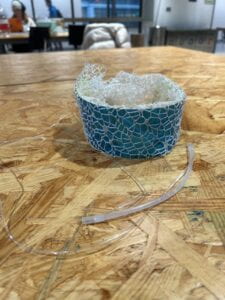
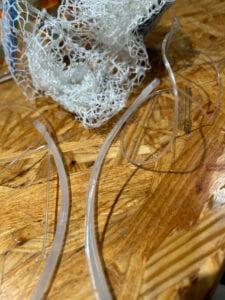


There are definitely better approaches to represent our ideas and we’re still working on it. This is only a rough prototype, but we want to really consider how wearables can inspire us to consider how certain mental feelings will reflect on our movements with certain wearables and influence our perceptions of the world and our senses.
Here is the video for our final output: